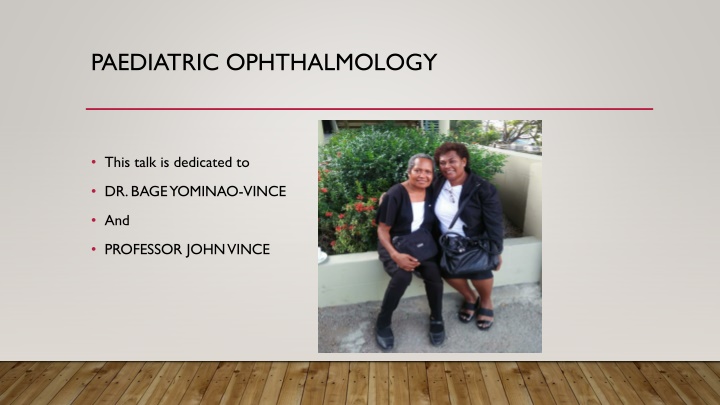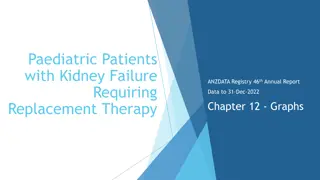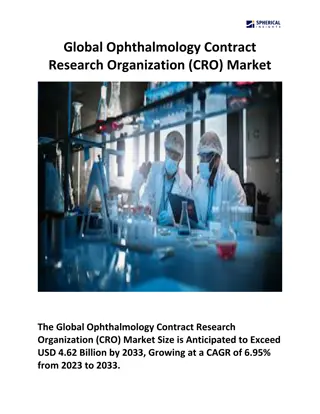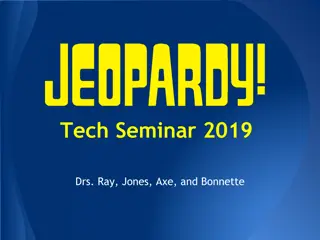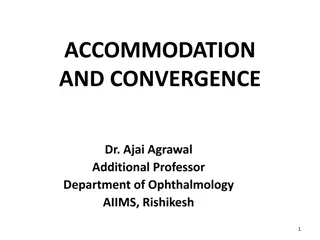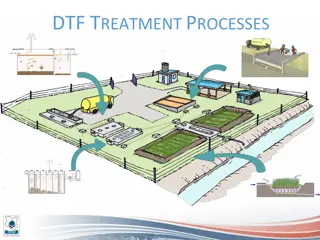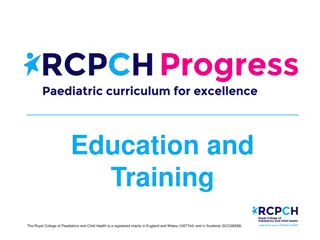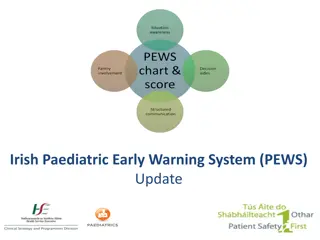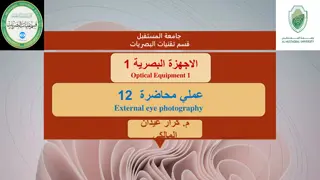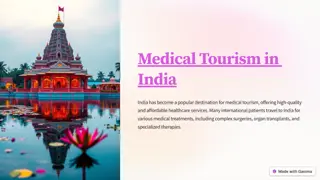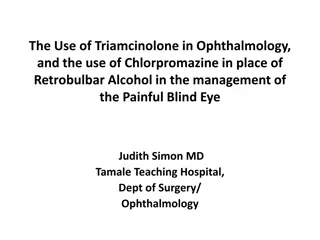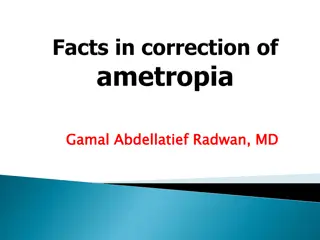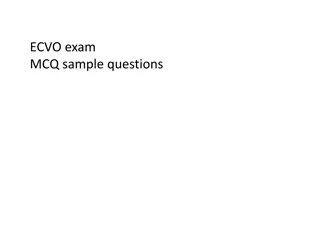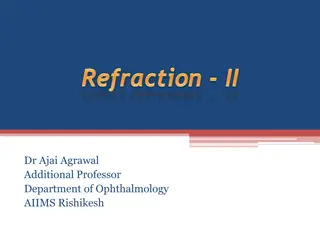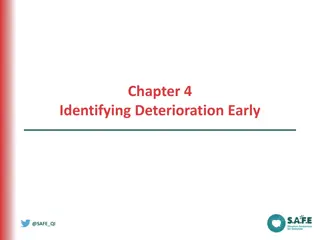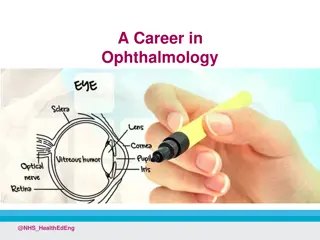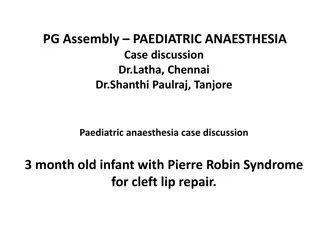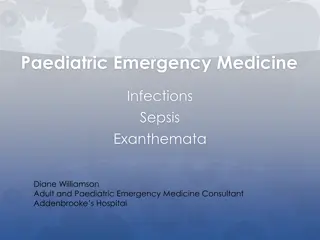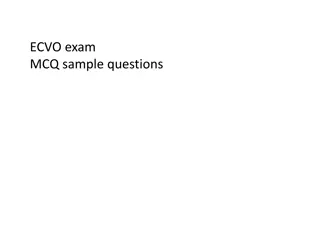Insights into Paediatric Ophthalmology: Common Conditions and Trachoma Treatment Strategies
Explore the world of paediatric ophthalmology through a detailed discussion on common eye conditions needing co-management, such as congenital anomalies and retinopathy, as well as the debilitating effects of trachoma caused by Chlamydia infection. Trachoma can lead to blindness if left untreated, especially in areas with poor sanitation and hygiene practices. Learn about WHO trachoma grading, life-long consequences, and effective treatment strategies to combat this eye disease. Discover the global endemic areas and available data on trachoma status, highlighting the importance of early detection and intervention in preventing blindness.
Download Presentation

Please find below an Image/Link to download the presentation.
The content on the website is provided AS IS for your information and personal use only. It may not be sold, licensed, or shared on other websites without obtaining consent from the author.If you encounter any issues during the download, it is possible that the publisher has removed the file from their server.
You are allowed to download the files provided on this website for personal or commercial use, subject to the condition that they are used lawfully. All files are the property of their respective owners.
The content on the website is provided AS IS for your information and personal use only. It may not be sold, licensed, or shared on other websites without obtaining consent from the author.
E N D
Presentation Transcript
PAEDIATRIC OPHTHALMOLOGY This talk is dedicated to DR. BAGE YOMINAO-VINCE And PROFESSOR JOHN VINCE
COMMON PAEDIATRIC EYE CONDITIONS REQUIRING CO-MANAGEMENT -CONGENITAL ANOMALIES/cataract,glaucoma,colobomas, TUMOUR- RETINOBLASTOMA RETINOPATHY OF PREMATURITY VITAMIN A DEFICIENCY TRAUMA TB etc
TRACHOMA TRACHOMA is a chronic conjunctival inflammation caused by Chlamydia Trachomatis- serotypes A,Ba,and C Initial infection in children is usually self limiting but with repeated infection ,it can lead to conjunctival scarring, trichiasis and cornea opacity leading to blindness It is associated with poverty, overcrowding, dirty environment, dry arid/dessert areas, poor access to water and sanitation, sharing towels VECTOR- common house fly
LIFE LONG JOURNEY OF TRACHOMA LEADING TO BLINDNESS
TREATMENT STRATEGY FOR TRACHOMA SAFE S- trichiasis surgery/ early on- epilation, ablation eye lash A- antibiotics AZITHROMYCIN (20mg/kg)- treat the family F- facial cleanliness E environmental cleanliness- water and sanitation
DATA AVAILABLE WHO indicates PNG trachoma status as ENDEMIC No proper survey has been done 1972-a survey done in Manus province (4.6% TF) 1979-80 Survey in Hanuabada- 4% 1982-Dr. Parsons, 2yr survey of school children in Madang (6153/19.6%) 1980-89; Madang clinic-18/30,441(0.06%)
WHAT IS OUR STORY ?? IS TRACHOMA ENDEMIC AND BLINDING Trachoma rapid assessment was done in 2014-in 6 districts (824 children)=11%TF WHO recommends prevalence survey if TF>10% PBL strongly recommended- GTMP Global Trachoma Mapping Project must be done ha with serology. 6 districts surveyed , 19,013 registered/17,046 consented. 5991 children 1-9 yrs examined (6585 registered) 4/6 districts had TF> 10%. WHO recommends MDA and implement SAFE Only 4 TT in West New Britain Province (0.1% prevalence)
GTMP RESULTS WASH questionaires ( associations of trachoma) 4/6 districts - 0nly 20% proper sanitation facilities and <50% access to water
SEROLOGY RESULT Colin K. Macleod,1,a, Robert Butcher,1,a, Sarah Javati,2 Sarah Gwyn,3 Marinjho Jonduo,2 Mohammad Yazid Abdad,2,4 The proportion of children with TF who had CT infection was low across all 3 EUs (overall 2%). Anti-Pgp3 seroprevalence was 5.2% overall and there was no association between anti- Pgp3 antibody level and presence of TF. In 2 EUs, age-specific seroprevalence did not increase significantly with increasing age in the 1- to 9-year-old population. In the third EU, there was a statistically significant change with age but the overall seroprevalence and peak age-specific seroprevalence was very low
CONCLUSION Based on these results, together with similar findings from the Solomon Islands and Vanuatu, the use of TF to guide antibiotic mass drug administration decisions in Melanesia should be reviewed. TRACHOMA EXPERTS- recommended a ancillary survey to look for scarring within the EUs with TF > 10% This was done in January 2020 just before covid lock down
ACTION- WAIT FOR VANUATU PREPARED A DOSSIER TO WHO- TO SAY TRACHOMAWAS NOT A PUBLIC HEALTH PROB.- In March at the pacific regional trachoma workshop- PNG- represented by NDOH team agreed to apply for Dossier based on the research x 3 done .. We are stating with evidence that Trachoma is not a public health problem- that trachoma in PNG does not cause blindness.
RESULT- 1178 children between the age of 11-14 years were examined. 63/1178 (5%) of children examined had some degree of scarring, of which 54/63 (86%) were graded C1 and 9/63 (14%) were graded C2. There were only two cases of limbal signs, one of pannus (unilateral) and one of HPs (bilateral).
CONCLUSIONS 1. Clinical signs of scarring was low 2. lower than SI and Vanuatu 3. The pre-defined criteria for trachoma to be considered a problem requiring azithromycin MDA in this study was if 20% of 10 14-year-olds have C1 or C2 or C3 with concurrent pannus and/or HPs, or 5% of that age group have C2 or C3 with concurrent pannus and/or HPs (15). 4. In this study, the proportion of individuals with both scarring and limbal signs did not meet that pre-defined criteria for commencement of MDA.
PACIFIC REGIONAL TRACHOMA WORKSHOP MARCH 2023 PNG decided in the light of all the evidence we have collected that we do not need to implement Mass drug administration of Azithromycin.. We will go ahead and work on our DOSSIER As of 5 October 2022, 15 countries Cambodia, China, Gambia, Islamic Republic of Iran, Lao People s Democratic Republic, Ghana, Malawi, Mexico, Morocco, Myanmar, Nepal, Oman, Saudi Arabia and Vanuatu had been validated by WHO as having eliminated trachoma as a public health problem.
The World Health Assembly adopted resolution WHA51.11 in 1998, targeting the global elimination of trachoma as a public health problem with 2020 as the target date. The neglected tropical diseases road map 2021 2030, endorsed by the World Health Assembly in 2020 through its decision 73(33), sets 2030 as the new target date for global elimination.
Elimination of trachoma as a public health problem is defined as: (i) a prevalence of trachomatous trichiasis unknown to the health system of <0.2% in adults aged 15 years (approximately 1 case per 1000 total population), (ii) a prevalence of trachomatous inflammation follicular in children aged 1 9 years of <5%, sustained for at least two years in the absence of ongoing antibiotic mass treatment, in each formerly endemic district; plus (iii) the existence of a system able to identify and manage incident trachomatous trichiasis cases, using defined strategies, with evidence of appropriate financial resources to implement those strategies.
DOSSIER NDOH has now accepted trachoma program into her NTDs plan- We have some funding for our dossier preparation f and the F N E component of the SAFE Strategy from FHF- Australia.. One of the requirements for a successful application is to do a post MDA survey.. We will work with the current MDA program in WNBP ( Azithromycin for YAWs) and collect our 6 month post MDA survey. After 6 months we will go with them and collect data to see if Trachoma follicles is below 5% Surveillance of trachoma trichiasis is ongoing. Including the F n E programs
